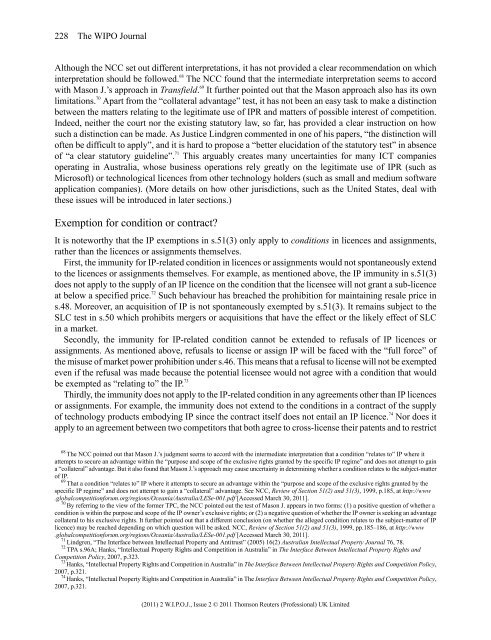WIPO Journal - World Intellectual Property Organization
WIPO Journal - World Intellectual Property Organization
WIPO Journal - World Intellectual Property Organization
You also want an ePaper? Increase the reach of your titles
YUMPU automatically turns print PDFs into web optimized ePapers that Google loves.
228 The <strong>WIPO</strong> <strong>Journal</strong><br />
Although the NCC set out different interpretations, it has not provided a clear recommendation on which<br />
interpretation should be followed. 68 The NCC found that the intermediate interpretation seems to accord<br />
with Mason J.’s approach in Transfield. 69 It further pointed out that the Mason approach also has its own<br />
limitations. 70 Apart from the “collateral advantage” test, it has not been an easy task to make a distinction<br />
between the matters relating to the legitimate use of IPR and matters of possible interest of competition.<br />
Indeed, neither the court nor the existing statutory law, so far, has provided a clear instruction on how<br />
such a distinction can be made. As Justice Lindgren commented in one of his papers, “the distinction will<br />
often be difficult to apply”, and it is hard to propose a “better elucidation of the statutory test” in absence<br />
of “a clear statutory guideline”. 71 This arguably creates many uncertainties for many ICT companies<br />
operating in Australia, whose business operations rely greatly on the legitimate use of IPR (such as<br />
Microsoft) or technological licences from other technology holders (such as small and medium software<br />
application companies). (More details on how other jurisdictions, such as the United States, deal with<br />
these issues will be introduced in later sections.)<br />
Exemption for condition or contract?<br />
It is noteworthy that the IP exemptions in s.51(3) only apply to conditions in licences and assignments,<br />
rather than the licences or assignments themselves.<br />
First, the immunity for IP-related condition in licences or assignments would not spontaneously extend<br />
to the licences or assignments themselves. For example, as mentioned above, the IP immunity in s.51(3)<br />
does not apply to the supply of an IP licence on the condition that the licensee will not grant a sub-licence<br />
at below a specified price. 72 Such behaviour has breached the prohibition for maintaining resale price in<br />
s.48. Moreover, an acquisition of IP is not spontaneously exempted by s.51(3). It remains subject to the<br />
SLC test in s.50 which prohibits mergers or acquisitions that have the effect or the likely effect of SLC<br />
in a market.<br />
Secondly, the immunity for IP-related condition cannot be extended to refusals of IP licences or<br />
assignments. As mentioned above, refusals to license or assign IP will be faced with the “full force” of<br />
the misuse of market power prohibition under s.46. This means that a refusal to license will not be exempted<br />
even if the refusal was made because the potential licensee would not agree with a condition that would<br />
be exempted as “relating to” the IP. 73<br />
Thirdly, the immunity does not apply to the IP-related condition in any agreements other than IP licences<br />
or assignments. For example, the immunity does not extend to the conditions in a contract of the supply<br />
of technology products embodying IP since the contract itself does not entail an IP licence. 74 Nor does it<br />
apply to an agreement between two competitors that both agree to cross-license their patents and to restrict<br />
68 The NCC pointed out that Mason J.’s judgment seems to accord with the intermediate interpretation that a condition “relates to” IP where it<br />
attempts to secure an advantage within the “purpose and scope of the exclusive rights granted by the specific IP regime” and does not attempt to gain<br />
a “collateral” advantage. But it also found that Mason J.’s approach may cause uncertainty in determining whether a condition relates to the subject-matter<br />
of IP.<br />
69 That a condition “relates to” IP where it attempts to secure an advantage within the “purpose and scope of the exclusive rights granted by the<br />
specific IP regime” and does not attempt to gain a “collateral” advantage. See NCC, Review of Section 51(2) and 51(3), 1999, p.185, at http://www<br />
.globalcompetitionforum.org/regions/Oceania/Australia/LESe-001.pdf [Accessed March 30, 2011].<br />
70 By referring to the view of the former TPC, the NCC pointed out the test of Mason J. appears in two forms: (1) a positive question of whether a<br />
condition is within the purpose and scope of the IP owner’s exclusive rights; or (2) a negative question of whether the IP owner is seeking an advantage<br />
collateral to his exclusive rights. It further pointed out that a different conclusion (on whether the alleged condition relates to the subject-matter of IP<br />
licence) may be reached depending on which question will be asked. NCC, Review of Section 51(2) and 51(3), 1999, pp.185–186, at http://www<br />
.globalcompetitionforum.org/regions/Oceania/Australia/LESe-001.pdf [Accessed March 30, 2011].<br />
71 Lindgren, “The Interface between <strong>Intellectual</strong> <strong>Property</strong> and Antitrust” (2005) 16(2) Australian <strong>Intellectual</strong> <strong>Property</strong> <strong>Journal</strong> 76, 78.<br />
72 TPA s.96A; Hanks, “<strong>Intellectual</strong> <strong>Property</strong> Rights and Competition in Australia” in The Interface Between <strong>Intellectual</strong> <strong>Property</strong> Rights and<br />
Competition Policy, 2007, p.323.<br />
73 Hanks, “<strong>Intellectual</strong> <strong>Property</strong> Rights and Competition in Australia” in The Interface Between <strong>Intellectual</strong> <strong>Property</strong> Rights and Competition Policy,<br />
2007, p.321.<br />
74 Hanks, “<strong>Intellectual</strong> <strong>Property</strong> Rights and Competition in Australia” in The Interface Between <strong>Intellectual</strong> <strong>Property</strong> Rights and Competition Policy,<br />
2007, p.321.<br />
(2011) 2 W.I.P.O.J., Issue 2 © 2011 Thomson Reuters (Professional) UK Limited

















